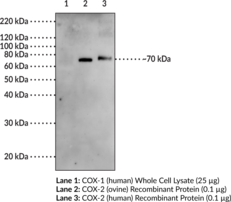Description
Severe acute respiratory syndrome coronavirus (SARS-CoV) surface glycoprotein, also known as the spike glycoprotein, is encoded by the S gene in SARS-CoV RNA.{53462} SARS-CoV is a member of the Betacoronavirus genus of viruses and has an approximately 79% sequence identity with SARS-CoV-2, the causative agent of COVID-19.{53459,53461} The spike protein of SARS-CoV and the related viruses SARS-CoV-2 and Middle East respiratory syndrome coronavirus (MERS-CoV) is a transmembrane glycoprotein that assembles into homotrimers on the virus surface and is comprised of an N-terminal S1 subunit, which contains the receptor binding domain (RBD), and a C-terminal S2 subunit, which facilitates fusion between viral and host cell membranes.{46767,46768,49561} The 193-amino acid RBD of the SARS-CoV spike protein is a target for neutralizing antibodies.{46768,49525} The SARS-CoV RBD, which spans amino acid residues 318 to 510, is 73% identical to that of SARS-CoV-2 and can bind to human angiotensin-converting enzyme 2 (ACE2), which is the host cell surface receptor for both SARS-CoV and SARS-CoV-2.{46768,46767,49525,49561} SARS-CoV is the causative agent of SARS, a primarily respiratory illness characterized by fever, cough, shortness of breath, and an approximately 10% fatality rate.{53461} Cayman’s SARS-CoV Surface Glycoprotein S1 Subunit Polyclonal Antibody can be used for ELISA and Western blot (WB; reducing conditions) applications.
Synonyms: SARS-CoV Spike Glycoprotein
Immunogen: Recombinant SARS-CoV surface glycoprotein S1 subunit
Formulation: 50, 100, or 200 µl of SARS-CoV surface glycoprotein S1 subunit affinity chromatography
Isotype: IgG
Applications: ELISA and WB (reducing conditions)
Origin:
Stability: 365 days
Application|ELISA||Application|Western Blot||Product Type|Antibodies|Polyclonal Antibodies||Research Area|Immunology & Inflammation|Pulmonary Diseases|MERS||Research Area|Infectious Disease|Viral Diseases|Coronaviruses




